

HE Bates | Frank Bellamy | J L Carr | Sir Alfred East | Sophie Green | John Alfred Gotch | Thomas Cooper Gotch | Tony Ireson | William Knibb | Derek Tompkins | Charles Wicksteed
 |

| |
| Home | News | Programme | Rose Bowl Award | Blue Plaques | Local Area | Local People & Issues | Mural | Publications | Society Shop | Links & Contacts | Planning | Events | Membership Details | ||
|
HE Bates | Frank Bellamy | J L Carr | Sir Alfred East | Sophie Green | John Alfred Gotch | Thomas Cooper Gotch | Tony Ireson | William Knibb | Derek Tompkins | Charles Wicksteed |
||
Click
here to view the Blue Plaque Detective Trail
To download the Trail, right click on the link above, and select
'Save target as'
|
The Society has begun its Heritage Trail by placing
plaques around the town to commemorate well-known people who have
contributed to Kettering's history.
We also have a wish list for Blue Plaques for Women in Kettering
|
||
|
|
||
|
Sir Charles Wicksteed (1847-1931) link to Open Plaque entry - map
Charles Wicksteed was the son of a Leeds Unitarian minister; from an early age he showed mechanical talents. After serving an apprenticeship in locomotive engineering works, he started up a steam ploughing business, which brought him to Kettering. He opened a small works in Stamford Road where he built up a successful engineering firm. A passionate and opinionated politician, Wicksteed was to play a prominent part in the life of the towns politics, being an ardent disciple of Gladstone. Passionate, irascible and individualistic, having failed to persuade the Local Board to open a public park, in the end he made one of his own. Although not a local man in origin, Charles Wicksteed became one of the most characteristic of businessmen of the later Victorian era. After having to struggle to make his business successful, eventually he made a good deal of money. In 1911 Wicksteed purchased 400 acres of the Barton Hall estate and in 1916 formed Wicksteed Village Trust, which was endowed with shares in his firm. It was somehow characteristic of him to risk his business for a project he believed in. His original plan was to develop a model village of low cost prefabricated houses, but with the arrival of council houses after 1918, this idea was abandoned. Some land was sold for private housing. With the remaining 140 acres Wicksteed embarked on plans for what was to evolve into the first children's recreational park in the country. He started with a boating lake in 1919 and a huge programme of tree felling. Two years later, the park was officially opened. By then, he had already spent £50,000. At regular intervals, new features were added. The park became popular with children and adults alike, one of its great virtues being that there was plenty of space to absorb the largest crowds. Wicksteed, always accompanied by his dog, was a familiar figure there. In 1928 he spent another £60,000 on the purchase of Barton Hall, which eventually became a hotel and later an old peoples home. Most popular at the weekend and at holiday times, the park is open every day for people to walk in. Nowadays, entry is free but there is a charge for motorcars. Wicksteed placed its future in the hands of a charitable trust and each year donations are made to charities out of the profits. Charles Wicksteed died, in 1931. His body lay in state in the pavilion in his park, the continuing existence of which keeps his memory alive. Extract from "A History of Kettering" by RL Greenall
Sir Alfred East R.A. (1844-1913)
Alfred was born in
Lower Street Kettering in 1844. He was the youngest of a family of eleven
children part of the East Shoemaking dynasty. He drew and painted from an early
age and this was continued when he was old enough to go to the Grammar School.
However, neither school nor his family gave him any particular encouragement
beyond that of recognising his talent. Despite being totally obsessive about his
art his parents sent him to work in a shoe factory owned by his brother Charles. Over the next thirty or so years he painted and travelled widely in Britain
and Europe. As his fame grew he extended his travels further a field including a
productive visit to Japan in the late 1880’s. Initially more acclaimed in Europe
than in his native country, eventually in 1899 he was elected A.R.A. Associate
of (R.A.) in recognition of his work in capturing the particular qualities of
the English landscape. His work did reflect the mood of the new century and in
the next decade honours were showered upon him from all over the world. Sadly Sir Alfred East who had just been elected as a full Academician (R.A.) was too ill to attend and died aged 69 less than three months later. Acknowledgement
Frank
Alfred Bellamy (1917-1976)
Frank Bellamy, voted at a New York Awards Ceremony as the best non-American illustrator in the world, was born in Kettering in 1917. He was brought up in Bath Road and educated locally. On leaving school he produced a regular comic strip for the Kettering Evening Telegraph’s ‘Pink ‘Un’ sports paper whilst working for William Blamir on Kettering’s High Street designing film posters for local cinemas. Frank did his National Service in County Durham where he met his wife Nancy. In 1948 he migrated to where he needed to be- London, working as a commercial artist. After a period of doing illustration work for a variety of magazines he eventually moved into ‘comics’. His first comic was Mickey Mouse Weekly where his output was actually signed ‘Walt Disney’! He soon moved on to Swift magazine, a stable mate of the famous Eagle comic and he made his name with exciting layouts and revolutionary colour. By the late fifties he had finally become established as one of the foremost strip artists in the country. Probably his most memorable creative work was the up dating of Eagle Comics famous Dan Dare strip. Throughout the late sixties and early seventies he contributed to many periodicals including the Sunday Times and the Radio Times. His work for Radio Times included work on Dr Who resulting in two ‘covers’ of the character. In 1971, five years before his death he took over the Garth Strip in the Daily Mirror and later moved back to Kettering with Nancy. Frank Bellamy died of a heart attack in 1976 age 59. The Civic Society placed a memorial blue plaque on his house at Bath Road. Biography by Robert Mercer (Vice Chairman - Kettering Civic Society 2005)
Thomas Cooper Gotch (1854-1931)
Thomas Cooper Gotch was born in the Mission House Kettering on December 10th 1854. He was the third son of Thomas Henry Gotch. Thomas Henry was a member of the well-known Kettering banking and shoe making family. One of three brothers they inherited the family wealth when their father died in 1852. Frederick William Gotch didn’t enter the business but John Davis did and lived in Chesham House, the family home just across the road. Unfortunately through mismanagement the bank collapsed amid financial panic in 1857. Thomas Henry, much distressed, left Kettering with his family that year but when in 1863 with the help of various other family members, the shoe making business was rescued and began to thrive again, he returned to Kettering to help rebuild the firm. He eventually even moved back to Chesham House being able to purchase it from his friend J.T.Stockburn in 1871. So Thomas Cooper, now a growing boy was also back in the town and went to Kettering Grammar School in 1869 aged 15 having been up to that time educated at various private institutions. By 1873 he was working for the family boot and shoe business travelling about the country and negotiating contracts and sales. Inclined towards the arts he was however unhappy working in the firm and considering that a “life in boots and shoes would be a life lost”. As the Gotch’s had friendly connections with the families of the artists Alfred East, Edmund Whimperis and John Trivett Nettleship they asked for advice in deciding Tom’s future. In the event Thomas Cooper Gotch began his career as an artist by enrolling at Heatherley’s Art School in London in 1876, with a view to getting accepted as soon as possible into the Royal Academy Schools. From then on his life and travels as an artist are typical of the period. He married Caroline Burland Yates in 1881 at Newlyn in an area of Cornwall that became increasingly important to him. (He even became President of the Newlyn Boy Scouts Association). His year-by-year development is admirably covered in Pamela Lomax’s book ‘The Golden Dream’, published by Sansom & Company (ISBN 1-904537-21-9) It is too detailed and varied to be repeated here. He died in London on May 1st 1931. His wife Caroline was able to come up from Newlyn to be with him after he suddenly became ill at the R.A. on varnishing day of that year’s exhibition and a memorial exhibition was held in Kettering the following year. Biography by Robert Mercer (Vice Chairman - Kettering Civic Society 2005)
|
||
|
Joseph Lloyd Carr
(1912-1994)
Born 20 May 1912 Thirsk Junction, Carlton Miniott, Yorkshire and died 26 February 1994 Kettering, Northamptonshire Joseph called himself "Jim" or even "James" and was an English novelist, publisher, teacher, and eccentric. Carr was born in Yorkshire, into a family of Wesleyan Methodists. His father Joseph, the eleventh son of a farmer, rejected farming as a career and went to work for the railways, eventually becoming a station master for the North Eastern Railway. Carr was given the same Christian name as his father and the middle name Lloyd, after David Lloyd George, the Liberal prime minister. He adopted the names Jim and James in adulthood. His brother Raymond, who was also a station master, called him Lloyd. Carr's early life was shaped by failure. He attended the village school at Carlton Miniott, Yorkshire. He failed the scholarship exam, which denied him a grammar school education, and on finishing his school career he also failed to gain admission to teacher training college. Interviewed at Goldsmiths' College, London he was asked why he wanted to be a teacher. Carr answered: "Because it leaves so much time for other pursuits." He was not accepted. Over forty years later, after his novel The Harpole Report was a critical and popular success, he was invited to give a talk at Goldsmiths'. He replied that the college once had its chance of being addressed by him. He worked for a year as an unqualified teacher - one of the lowest of the low in English education - at South Milford Primary School, where he became involved in a local amateur football team which was startlingly successful that year. This experience he developed into the novel How Steeple Sinderby Wanderers Won the FA Cup. He then successfully applied to a teacher training college in Dudley. In 1938 he took a year out from his teaching career to work as an exchange teacher in Huron, South Dakota in the Great Plains. Much of the year was a struggle to survive in what was a strangely different culture to him; his British salary converted into dollars was pitifully inadequate to meet American costs of living. This experience gave rise to his novel The Battle of Pollocks Crossing. At the end of his year in the USA Carr continued his journey westward and found himself travelling through the Middle East and the Mediterranean as the Second World War loomed. He arrived in France in September 1939 and reached England, where he volunteered for service in the Royal Air Force. He was trained as an RAF photographer and stationed in West Africa, later serving in Britain as an intelligence officer, an experience he translated into fiction with A Season in Sinji. At the end of the War he married Sally (Hilda Gladys Sexton) and returned to teaching. He was appointed headmaster of Highfields Primary School in Kettering, a post he filled from 1952 to 1967 in a typically idiosyncratic way which earned the devotion of staff and pupils alike. He returned to Huron, South Dakota in 1957 to teach again on an exchange visit, when he wrote and published himself a social history of The Old Timers of Beadle County. In 1967, having written two novels, he retired from teaching to devote himself to writing. He produced and published from his own Quince Tree Press (still active) a series of 'small books' designed to fit into a pocket: some of them selections from English poets, others brief monographs about historical events, or works of reference. In order to encourage children to read, each of the "small books" was given two prices, the lower of which applied only to children. As a result, Carr received several letters from adults in deliberately childish writing in an attempt to secure the discount. He also carried on a single-handed campaign to preserve and restore the parish church of St Faith at Newton in the Willows, which had been vandalised and was threatened with redundancy. Carr, who appointed himself its guardian, came into conflict with the vicar of the benefice, and higher church authorities, in his attempts to save the church. The building was saved, but his crusade was also a failure in that redundancy was not averted and the building is now a scientific study centre. In 1986 Carr was interviewed by Vogue magazine and, as a writer of dictionaries, was asked for a dictionary definition of himself. He answered: "James Lloyd Carr, a back-bedroom publisher of large maps and small books who, in old age, unexpectedly wrote six novels which, although highly thought of by a small band of literary supporters and by himself, were properly disregarded by the Literary World". Jim Carr died of leukaemia in Kettering on 26 February 1994 aged 82 years. Acknowledgement: The Great Meeting
Toller United Reformed Church has been part of the history of Non-Conformity in Kettering for over 345 years. The first non-conformists in Kettering railed round the then Rector of Kettering, the Revd John Maidwell when he resigned his living on the enforcement of the Act of Uniformity in August 1662. Although no worship or preaching was allowed, these early non-conformist Christian believers met secretly in members’ and relative’s houses, mostly at a cottage in Hazelwood Lane. Around 1685 when more freedom was allowed in worship, a converted barn behind High Street was opened for services. Called “The Independent Meeting” and founded on “Congregational” principles the building could hold 400 people. When Revd John Maidwell died in 1693 ironically, he was buried in the chancel of Kettering Parish Church. Among the worshippers were Baptists, Congregationalists and Presbyterians but in 1696, because of their views on baptisms, the Baptists formed their own church (The Little Meeting). The meetings flourished and congregations grew rapidly and in 1723 a new church was built on Bakehouse Hill, now Gold Street. Seating nearly 800 and at a cost of £543 it was then the next in size in Kettering to the Parish Church. In its’ long history the church has had a great variety of names starting with the “Christian Church of Kettering”, “The Independent Meeting House” and “The Great Meeting”. In 1776 a century of ministry under the name of Toller began with the induction of Revd Thomas Northcote Toller, succeeded in 1821 by his son Revd Thomas Toller. The church then became known as “Toller’s Chapel” later “Toller Congregational Church” and now “Toller United Reformed Church”. With the growing number of pupils attending, a new building was erected adjoining the church in 1849. In 1883 the church felt the need for even better facilities and built a new Sunday School in Meeting Lane. In 2006 this building was refurbished and renamed “Toller Meeting Rooms”. In 1898 the structure of the church was drastically altered from a Puritan Meeting House to a Victorian Church, with the addition of towers and vestries. A major step was taken in 1979 when pews were removed and a multi-purpose Church evolved, but the main structure of the first building is still the main part of the Church. In 1972 the amalgamation of the Congregational Church of England and Wales with the English Presbyterian Church brought into being the United Reformed Church. The Church is now known as Toller United Reformed Church. The present Church is often used by various groups and organisations of the town for music, drama and exhibitions. It is also a focal point for services and processions of the Churches Together in Kettering.” Link to Open Plaques - map
William Knibb arrived in the land of "sin disease and death" and was outraged
at the ill-treatment and moral degradation of the slaves imported from Africa.
Local Hero who freed the slaves - a tribute to 'King' Knibb - from an article by Tony Smith in the Evening Telegraph 6/6/02 You don't need to he a student of local history to be aware of legendary missionary William Knibb, after whom a youth and education centre in Montagu Street, Kettering, is named. His crucial role in the education and emancipation of, slaves In the British colonies in the 19th century is recognised in his home town's coat of arms, which features a black man with broken manacles. Now a new book paying tribute to the work of Knibb and his fellow campaigners in the West Indies has been published by a Kettering-born university professor, whose father was a minister at Fuller Baptist Church, which helped found the world-wide Baptist Missionary Society In 1792. Civilising Subjects (Polity Press, £19.99) is written by Catherine Hall, Professor of Modem British Social and Cultural History at University College, London. She was three when her family left Kettering in 1949 for Leeds, where her father, the Rev John Barrett, was appointed area superintendent of the Baptist Union. But it wasn't until 1988, when she and husband Stuart had gone to live In his native Jamaica, that she stumbled across a small village called Kettering and her curiosity about its origins led to intensive research which eventually resulted in the book. The village was founded by Knibb as the base for his Christian mission and his stirring public addresses against the evil slave trade were instrumental in -Its abolition in the colonies in 1833. It was at his Island home that the golden jubilee of the Baptist Missionary Society was celebrated and where he died, aged 44, of yellow fever. "King Knibb", as he was known by those he helped free, was born in Market Street and educated at Kettering Grammar School. In 1823 he was Rent to Jamaica as a missionary to replace his brother Thomas, who died teaching in Kingston, and after arriving with new wife Mary, he wrote to a friend: "I have now reached the land of sin, disease and death." Outraged by the ill-treatment and moral degradation of mostly negro slaves imported from Africa, he soon became an outspoken thorn in the side of plantation bosses. When a revolt by slaves broke out in 1831, he was arrested by the Jamaican government, which blamed missionaries for stirring up unrest. On visits home, Knibb lectured passionately throughout Britain to rally support for abolition. He envisioned a world where freed black men and white missionaries could build a new society and dreamed of an independent Jamaica, governed by black freeholders. "Such a dream was built, however, on the refusal to recognise An existing black culture," writes Prof Hall in her diligently researched book, "For, once established, the free villages could not be maintained In the missionary image." After abolition, plantation owners felt Knibb - by then recognised leader of the missionaries in Jamaica - still posed a threat to their interests, some suspecting he had ambitions of becoming ruler of the colony. He had houses in both the villages of Kettering and nearby Falmouth with horses and servants, among them two African girls he rescued from a captured slave ship. When Knibb died, his wife Mary stayed in Jamaica until her death in 1867. Today their graves are in the churchyard of the present William Knibb Memorial Chapel, in Falmouth, erected after the old chapel he founded was destroyed in a hurricane in 1944, Prof Hall argues that the missionary dream relied on willing lieu- tenants who would extend the work of the white pastors, but there were many tensions and clashes between the missionaries. The author concludes.' "While the early 1840s represented the high point of missionary hopes, fractures were already evident within the Baptist family. The death of Knibb marked the ending of the high watermark of post-emancipation missionary dreams." William Knibb - A Champion of Freedom - from an article by Tony Smith in the Evening Telegraph 1/12/00 The crucial role played by Kettering in the education and emancipation of slaves in the British colonies is symbolised in the borough's coat of arms. The circles at the top of the shield represent the founding of the worldwide Baptist Missionary Society in the town's Lower Street in 1792. The black slave on the right with broken manacles a tribute to one of its most famous members, the freedom champion William Knibb. Slavery was rife in the British Empire during the late 18th century and was,outlawed in 1807 after opposition led by the likes of the philanthropist William Wilberforce. Although this made it illegal for British ships or for British colonies to import them, in was 1803 before it was abolished in the colonies themselves following a campaign by Knibb The former Kettering Grammar School pupil, born in Market Street in 1806 was sent to Jamaica as a missionary to replace his eldest brother Thomas, who had died, suddenly in Kingston in 1824. Full of zeal William became pastor of a church at Falmouth on the island but was horrified by the ill-treatment of sugar plantation workers, mostly negro imported on slave ships from Africa. Unlike fellow missionaries, Knibb,dared to speak out against such cruelty and injustice. When a revolt by slaves broke out in 1831, he was arrested by the Jamaican government, which blamed the, missionaries for stirring up unrest. On returning to England the following year, Knibb tirelessly lobbied the church, Parliament and the House of Lords, vowing: "I will not rest day or night till this accursed thing is swept from the face of the earth". In a landmark speech to the Baptist Missionary Society, he spoke passionately of the horrors of slaughtered negroes and their families, imprisoned missionaries and demolished chapels. "I plead on behalf of the widows and orphans whose innocent blood has been shed," he said, "I call upon children by the cries of the Want slave whom I saw flogged on the Macciesfield estate. I call upon parents by the blood streaming from the back of Catherine Williams, who, with a heroism England has seldom known, preferred the dungeon to the surrender of her honour. "I call upon Christians by the bleeding wounds of William Black, whose back a month after flogging was not healed The excitement of the meeting was indescribable. After similar emotive meetings, throughout England, a Reform Bill abolishing slavery was eventually passed. As the clock struck midnight on July 31, l838, 800,000 negro workers in the West Indies were finally declared free (and their former owners handsomely compensated) Although William arrived back in Jamaica too late for Emancipation Day, he was mobbed at the bay by hundreds of jubilant people from ever corner of the island. Amid much weeping, laughing and singing the crowds hailed him as "King" Knibb". In subsequent years, thousands flocked to the churches in the colonies. Numbers of Christians rose from 4,000 in 1825 to 27,607 in 1840, Knibb himself baptising 6,000 converts. Largely through his efforts, 35 chapels, 16 schools and 24 mission house, were erected at a cost of £157,000, of which the people raised £139,000. Knibb returned here in 1842 to celebrate the golden jubilee of the BMS at the Mission House in Kettering. Following a final fundraising mission to England inouth in Jamaica and named after his beloved birthplace. He died there of yellow fever in 1847. Today Kettering Baptist Church founded by Knibb in 1544 survives on the island along with the William Knibb Memorial High School. In Kettering, England, a bronze bust of the missionary is display, in the Manor House Museum and a youth education centre in Montagu Street bears his name.
|
||
Tony Ireson (1913 -
14th Feb 2002)
link to Open
Plaque entry - map
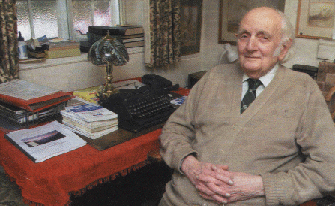
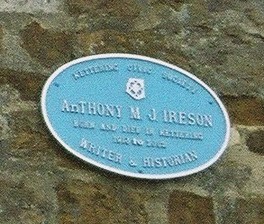

A Tribute by Paul Ansell Chairman of Kettering Civic Society
"Need you ask so many questions?" I remember the White Rabbit asking Alice. With the curiosity and inquisitiveness of a child came the regular flow of questions from Tony, yet, as behind Alice, was a very intelligent author. I'm sure this curiosity in Tony was something, like his impish charm, he was born with.
His family had been stonemasons and carvers for several generations, and men working with craftsman's skill and natural products-usually stone, was Tony's childhood background. His cousin was Archie Ireson. Having reached 88years, he could look back over a lifetime of change. Being taken as a child by the family horse and cart had been a pleasure particularly if given the chance to hold the reigns. Lately he was a proud Triumph car owner.
As a journalist he would now be an E-mail man. It's not hard to see how this early upbringing developed in him a love of the countryside and carefully crafted buildings set in it. Having been educated locally and worked locally, he never really wanted to leave Kettering even though he spoke with some fondness of India. As a journalist, my link back to Alice, has a more serious side. Tony's questions were always searching for answers, put in an intelligent way, with thought behind them but never a vicious or scandalous edge. Where he considered he might be personally hurtful, he left things unsaid. I like to think this was the Christian side of Tony. In 1954 he wrote his first published book 'Northamptonshire History' which was to become a best seller. With an ear for local phrases and expressions, he picked up and incorporated the way Northamptonshire people were, into his writing. Photographic illustrations were his also.
From the Civic Society, we remember him as a founder member. The Town will remember Tony's Civic Society work in connection with Kettering Town Centre Redevelopment and particularly the saving of Beech Cottage, which now stands as a memorial to him and a reminder to the town of how things were. It is now a Gallery of his father's paintings. All towns grow and evolve and it was the caring side of this evolution of Kettering with which Tony associated himself. It was for his 'Care Quality' that I think everyone respected him.
There was always a sense of humour with what he said and did. During the Build-up to Kettering entering the Redevelopment Epidemic of the 1970's local politicians held meetings to win converts to their cause. At one of these meetings, Tony was to display his impish side.
Chaired by Councillor Barry Chambers, a full meeting, mostly of Politically minded folk, was joined at the back of the audience by Tony and a fellow Civic Society member. Heads turned, people murmured, and the chairman looked pensively and then launched into reasons why Kettering Town Centre should best be Blitzed and rebuilt. Tony proceeded to noisily unzip his briefcase and took out a clipboard and at the top of the sheet of paper wrote a short sentence. In front of Tony sat Alderman Len Smith. Tony tapped his shoulder and passed the clipboard to him. "Sign that please"... Len did and Tony urged with a dramatic whisper "Pass it on..." Gradually the board went round the whole seated audience who one by one signed the petition before it eventually came back to Tony. At this point, the other Civic Society member was able to read the petition, which read... 'SAVE THE WHALES'. The Chairman didn't know what had so broken the concentration of the audience but in a move, which Gatling Fen himself would have been proud of, Tony's impishness was well demonstrated and the meeting deflated.
Tony took early retirement to devote more time to opposing the development of the Newborough Centre, eventually saving Beech Cottage which I guess everyone will now try to save. What an irony.... Arrangements were made during the 70's for his cottage and we wait enthusiastically to learn what Tony had in mind. After Newborough Twin Towers crumbled, Tony devoted much of his time to writing and at the time of his death, he was nearing the completion of his 8th book.
Through all of Tony's investigations and missions he was caringly supported by 'Rene' his devoted wife and always accompanied by their spaniel. It was Rene's enthusiasm for gardening, which gave the grounds of Beech Cottage its charming appearance. As editor of Garden News he no doubt sought other helpful advice and he occasionally made mention of special plants that had come from the Chelsea Flower Show.
Civic matters always remained in his mind and he was a regular behind the scenes, worker and mentor. Lately it was the Civic Society secretary who called on him regularly to bring his thoughts back to our meetings. Tony has left us with memories of a charming intelligent, innocent man whose care for the world around him has left us a model in society to look up to and a conscience to protect and care for what is good.
The Civic Society and The Town say 'Good Bye' to one of it's GREATEST DEFENDERS. Click here for more information on Tony Ireson & the Beech Cottage saga
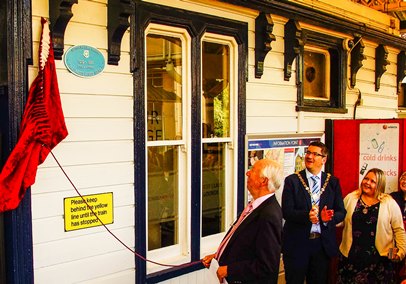
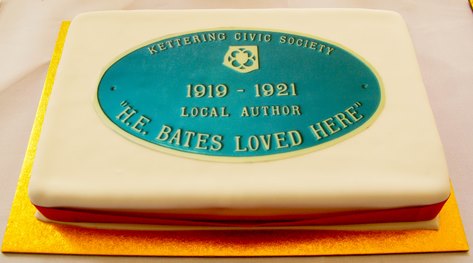
Plaque unveiled by HE Bate's Son, Richard at Kettering Raiklway Station
Cake made for the unveiling
H E Bates was born in 1905 in the shoe-making town of Rushden, Northamptonshire, and educated at Kettering Grammar School. After leaving school, he worked as a reporter and as a clerk in a leather warehouse. Many of his stories depict life in the rural Midlands, particularly his native Northamptonshire, where he spent many hours wandering the countryside.
His first novel, The Two Sisters (1926) was published by Jonathan Cape when he was just twenty. Many critically acclaimed novels and collections of short stories followed. During WWII he was commissioned into the RAF solely to write short stories, which were published under the pseudonym “Flying Officer X”. His first financial success was Fair Stood the Wind for France (1944), followed by two novels about Burma, The Purple Plain (1947) and The Jacaranda Tree (1949) and one set in India, The Scarlet Sword (1950). Other well-known novels include Love for Lydia (1952) and The Feast of July (1954).
His most popular creation was the Larkin family which featured in five novels beginning with The Darling Buds of May in 1958. The later television adaptation was a huge success. Many other stories were adapted for the screen, the most renowned being The Purple Plain (1947) starring Gregory Peck, and The Triple Echo (1970) with Glenda Jackson and Oliver Reed.
H E Bates married in 1931, had four children and lived most of his life in a converted granary near Charing in Kent. He was awarded the CBE in 1973, and died in 1974.
Writes: General Fiction, Bloomsbury Reader Author of : The Day of the Tortoise, The Triple Echo, The Song of the Wren, The Wild Cherry Tree, The Fabulous Mrs. V., The Four Beauties, The Yellow Meads of Asphodel, The Black Boxer Tales, An Aspidistra in Babylon, Death of a Huntsman, Now Sleeps the Crimson Petal and Other Stories, The Golden Oriole, Colonel Julian and Other Stories, Love for Lydia, The Watercress Girl, Cut and Come Again, The Complete Uncle Silas Stories, The Flying Goat, The Beauty of the Dead and Other Stories, The Nature of Love, Something Short and Sweet, The Bride Comes to Evensford, The Daffodil Sky, The Complete Flying Officer X Stories, The Cruise of The Breadwinner, The Wedding Party, Seven Tales and Alexander, The Woman Who Had Imagination, Day's End and Other Stories - See more at: http://www.bloomsbury.com
In his first autobiography, The Vanished World he writes of his first love being a girl called Con who he used to meet at Kettering Station on Platform 3. Quote, 'There is no practical reason whatever for there ever being erected a plaque on a house in London saying H E Bates lived here; but if there were any justice whatever in the history of railways and twentieth-century novelists there should be a plaque on the door of the first-class waiting-room on Platform 3 at Kettering station saying H E Bates loved here.'
John Alfred Gotch (28 September 1852 – 17 January 1942)
map
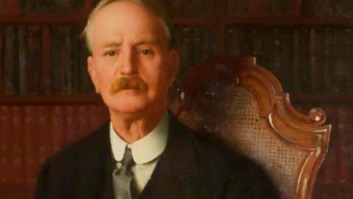 |
 |
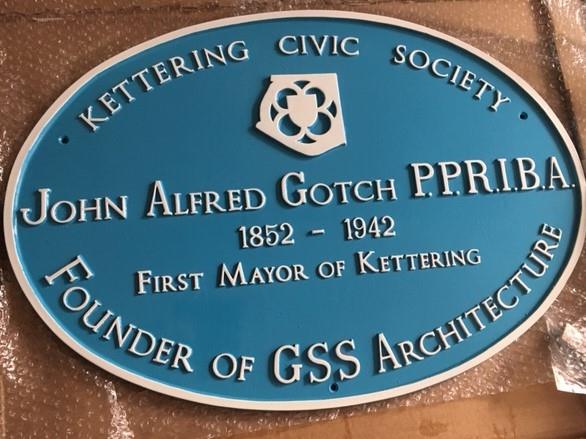 |
A noted British architect and architectural historian. His brother was the Pre-Raphaelite painter and illustrator Thomas Cooper Gotch, who painted this portrait.
He attended Kettering Grammar School and later studied at the University of Zürich and at King's College London.
In 1879 Gotch set up a private architectural practice in Kettering, Northamptonshire which developed into the firm Gotch & Saunders by entering into partnership with Charles Saunders in 1887. They were later joined by Henry Ralph Surridge and they jointly retired in 1938. The practice still exists as Gotch, Saunders & Surridge LLP, or GSS Architecture.
As well as designing many buildings (especially for the Midland Bank) Gotch had a special interest in Elizabethan and Jacobean architecture, and became a national authority on the subject through his writings. He was the author of nine books in this field (two of which were reissued), as well as editor of a book on the history of the Royal Institute of British Architects (RIBA). Apart from his renown as an architectural historian, he also achieved eminence as a public figure and representative of the architectural profession.
He was President of the Architectural Association in 1886-7, Vice-President of the RIBA in 1914-9, and President of RIBA in 1923-5: the first provincial architect to be appointed President since the formation of the Institute in 1834. In addition, he was Vice-President of the Society of Antiquaries, a founder member of the Royal Fine Art Commission, a Trustee of the Soane Museum, and President of the Northamptonshire Association of Architects in 1911-22. In 1924 he received an honorary MA degree from the University of Oxford.
John Alfred Gotch was appointed the first Charter Mayor of Kettering in 1938.
Acknowledgement: Dr Roy Hargrave BA (Hons), MA, PhD
Roy has a particular interest in architectural
watercolours and works by early Northamptonshire artists such as Sir Alfred East
and TC Gotch and is an authority on JA Gotch."
Derek Spencer Tompkins 1926-2013
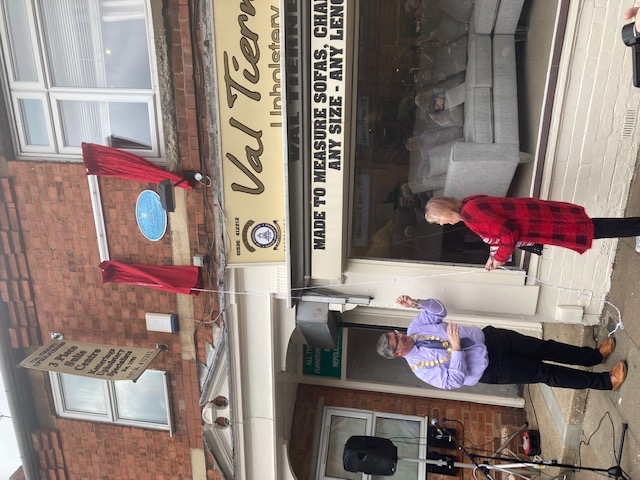
|
|
Question- What do record industry mogul David Foster and
record producers Trevor Horn and Max Norman have in common with Queen's
bass player John Deacon, Whitesnake's guitarist Bernie Marsden, plus
groups like St Cecilia, The Jets, Coast to Coast and goth punk pioneers
Bauhaus? Answer- they all began their recording careers at recording studios owned and run by Derek Tompkins.
His story is told in two recently
|
Sister Mary Anita (Liz), Catholic nun and nurse tutor noted for her pastoral care in and around Kettering
Elizabeth Morris, known as Sister Liz died peacefully at Kettering General Hospital on 13th January 2014.
Born in Devon, she spent her early years in Ireland and took her vows in 1952 as the only English nun in German Roman Catholic order with several houses in England. She was given the name Sister Anita but was known as Sister Liz.
She trained as a teacher and taught at (Our Lady’s Convent School) run by her order in Kettering. But nursing was her true vocation and she undertook the experimental combined SRN/RMN course run by Brunel University and Maudsley Hospital.
After a post as sister on a ward for patients with dementia in Bow, east London, Sister Liz became a nurse tutor in Greenwich. The care of the dying was always close to her heart and she completed a course in palliative nursing at St Joseph’s Hospice in Hackney.
Sister Liz returned to Kettering in 1983 and worked as a nurse tutor in the Northamptonshire School of Nursing until her retirement in 1991.
Many sets of nursing students benefited from her kindly pastoral care and support. At the convent, she took charge of nursing her increasingly frail German sisters.
Retirement did little to reduce her workload, and she became an assistant chaplain at Kettering General Hospital, completing an MA in chaplaincy studies at the University of Leeds. Sister Liz spent countless hours visiting the housebound of all faiths and non.
The sight of her striding around Kettering in her black habit, making yet another visit, was a familiar one. On the occasion of her golden jubilee in the order, the county newspaper rightly described her a ‘local legend’.
By John Adams - Honorary Research Associate, Faculty of Nursing and
Midwifery, Royal College of Surgeons in Ireland.
Nursing Standard January 28= Vol 29 no 22: 2015
Mary Theophenia Shayler 1876-1920 Kettering School Mistress
Taken from Mary Theophenia Shayler Kettering School Mistress 1876-1920 The First Fifty Years of Compulsory Education by L. Partridge B.A. Mary Shayler spent her whole life in the development of education in the growing country town of Kettering, and spent forty years of her life as Headmistress of two of its Church schools.
Two Schools Still they stand, brick and stone Memorials to a spirit that remains Still servants of a town that’s overgrown With motor roads their semi-rural lanes. There Mary Shayler in long sweeping skirts Imposed an aura of a precious joy, And dedicated discipline inserts To stir young minds their talents to employ
A hundred years have passed Since Florence, Nellie, Annie, learnt their trade They’ve gone, these Pupil Teachers of the past The segments of a pattern that’s inlaid.
For forty years her talents did she give To precious structure which shall ever live.
Sophie Green
1877- 1956
Local celebrity and educational pioneer
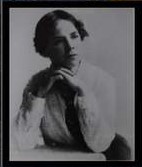
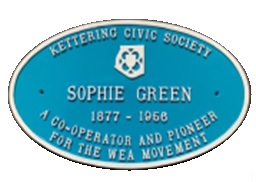
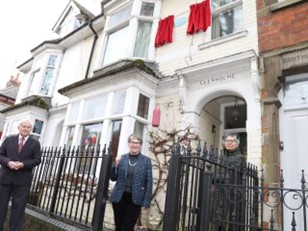
Paul Ansell, Keli Watts and Marta Mayhew (Board of Directors - Centre
England Co-operative)
after unveiling the plaque in St Peter’s Avenue
Sophie Green died in 1956, but some people in the area still remember her.
In her day, her work with the Cooperative movement, trade unions and above all the WEA, gave her local and national reputation.
Born in 1877 her family were from Titchmarsh (Northamptonshire) and were among the many attracted to Kettering as its industry expanded. Sophie Green lived in Cobden Street, later moving to St.Peters Avenue. She began work as a machinist in the Kettering Clothing Cooperative factory and then became active with the Workers’ Educational Association (WEA) as a student.
In 1919 she was appointed as Tutor Organiser for a special WEA scheme, in which role she carried out pioneering work with women in rural areas until 1939. She was also on the Board of Education and Poor Law Guardians. When she retired, the famous social thinker and historian of the WEA, R.H.Tawney, said: “It was Sophie Green, more than any other single person who laid the foundations on which the WEA’s later achievements in the area have been built. The establishment of new branches of classes: the extension of its influence in rural districts; the development of its work among women; the close and cordial relations between it and the Cooperative and trade union movements- every side in short of the Association’s activities bears the mark of her energy and wisdom.”
When reporting her death, the local paper said that she was generally known as “Our Sophie”
I am trying to discover more about this remarkable woman with a view to publishing a research paper and I would be pleased to speak to anyone who can add to what I have been able to discover. In particular, I would like to find out where in Grange Street the adult school, in which she also taught, was. I know that there are some who still remember her and any scrap of information to add to documentary evidence would be very welcome. I would also be pleased to hear from anyone who knows about her friend, Helen Stocks, of Oxford University. Sadly, though Sophie's grave plot number is recorded there is no grave stone.
By David Wilson
Acknowledgement: The Kettering Project website
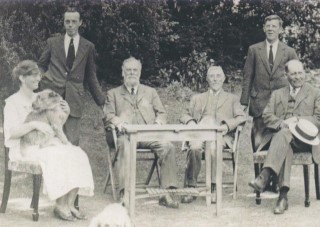
The original trust for Wicksteed Park - Hilda Wicksteed, Tom Atwell,
Charles Wicksteed, Frank Toseland, Ralph Wicksteed and Joseph Wicksteed
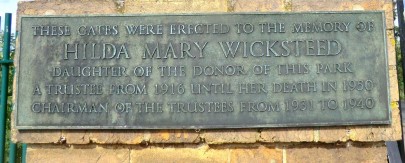
Hilda Wicksteed, daughter of park founder Charles, was born in 1884 and educated at Roedean School. Hilda became chairman of the Wicksteed Village Trust when her dad died in 1931 and took over his factory making playground equipment. She wrote plays and four books, including one about her father and another about his pet dog Jerry.
As an avid animal lover, Hilda set up a new Kettering branch of the RSPCA in 1924 and was commissioner of the local Girl Guides. The main park gates (above) were erected in her memory after she died in 1950.
op | HE Bates | Frank Bellamy | J L Carr | Sir Alfred East | John Alfred Gotch | Thomas Cooper Gotch | Tony Ireson | William Knibb | Charles Wicksteed